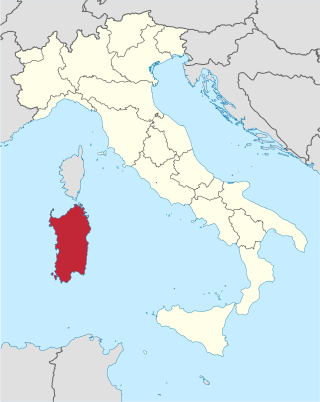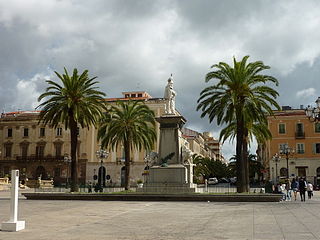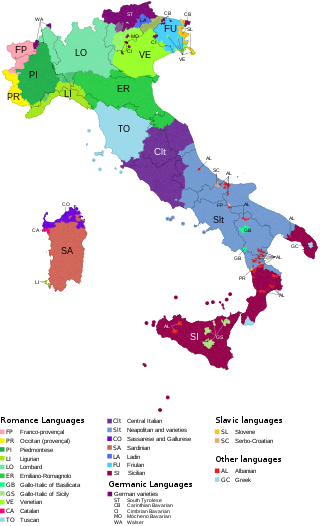
Grazia Maria Cosima Damiana Deledda was an Italian writer who received the Nobel Prize for Literature in 1926 "for her idealistically inspired writings which with plastic clarity picture the life on her native island [i.e. Sardinia] and with depth and sympathy deal with human problems in general". She was the first Italian woman to receive the prize, and only the second woman in general after Selma Lagerlöf was awarded hers in 1909.

Nuoro is a city and comune (municipality) in central-eastern Sardinia, Italy, situated on the slopes of Mount Ortobene. It is the capital of the province of Nuoro. With a population of 36,347 (2011), it is the sixth-largest city in Sardinia. Its frazione (borough) of Lollove is one of I Borghi più belli d'Italia.

Sardinian or Sard is a Romance language spoken by the Sardinians on the Western Mediterranean island of Sardinia.

Sardinia is the second-largest island in the Mediterranean Sea, after Sicily, and one of the twenty regions of Italy. It is located west of the Italian Peninsula, north of Tunisia and 16.45 km south of the French island of Corsica.

Cagliari is an Italian municipality and the capital and largest city of the island of Sardinia, an autonomous region of Italy. It has about 155,000 inhabitants, while its metropolitan city has about 420,000 inhabitants. According to Eurostat, the population of the functional urban area, the commuting zone of Cagliari, rises to 476,975. Cagliari is the 26th largest city in Italy and the largest city on the island of Sardinia.

Sassari is an Italian city and the second-largest of Sardinia in terms of population with 127,525 inhabitants, and a Functional Urban Area of about 260,000 inhabitants. One of the oldest cities on the island, it contains a considerable collection of art.

The languages of Italy include Italian, which serves as the country's national language, in its standard and regional forms, as well as numerous local and regional languages, most of which, like Italian, belong to the broader Romance group. The majority of languages often labeled as regional are distributed in a continuum across the regions' administrative boundaries, with speakers from one locale within a single region being typically aware of the features distinguishing their own variety from others spoken nearby.

Tirano is a town and comune (municipality) in Valtellina, located in the province of Sondrio, Lombardy. It has 9,053 inhabitants (2016) and is adjacent to the Switzerland-Italy border. The river Adda flows through the town.

Arbus is a comune (municipality) in the Province of South Sardinia in the Italian region of Sardinia.

The "Luigi Pigorini" National Museum of Prehistory and Ethnography was a public and research museum located in Rome, Italy. Established in 1875 and opened in 1876 by Luigi Pigorini, from 2016, its collections became part of the newly instituted Museo delle civiltà, currently directed by Andrea Viliani. The museum was housed in the Collegio Romano from 1875 to 1923.

The Nuragic civilization, also known as the Nuragic culture, formed in the Mediterranean island of Sardinia, Italy in the Bronze Age. According to the traditional theory put forward by Giovanni Lilliu in 1966, it developed after multiple migrations from the West of people related to the Beaker culture who conquered and disrupted the local Copper Age cultures; other scholars instead hypothesize an autochthonous origin. It lasted from the 18th century BC, or from the 23rd century BC, up to the Roman colonization in 238 BC. Others date the culture as lasting at least until the 2nd century AD, and in some areas, namely the Barbagia, to the 6th century AD, or possibly even to the 11th century AD. Although it must be remarked that the construction of new nuraghi had already stopped by the 12th-11th century BC, during the Final Bronze Age.

The Grandas de Salime Ethnographic Museum is a museum in Grandas de Salime, Asturias, Spain. It was founded by archaeologist José Naveiras Escanlar, also known as Pepe el Ferreiro, in 1984. It is an open-air museum that displays the traditional, peasant way of life in the region. It is managed by the Ethnographic Museums Network of Asturias.

The Sardinians, or Sards, are a Romance language-speaking ethnic group indigenous to Sardinia, from which the western Mediterranean island and autonomous region of Italy derives its name.

The Nivola Museum in Orani, Sardinia, Italy is an institution devoted to the work of artist Costantino Nivola (1911-1988) within the larger context of contemporary art, landscape, and living traditions.

The Byzantine age in Sardinian history conventionally begins with the island's reconquest by Justinian I in 534. This ended the Vandal dominion of the island after about 80 years. There was still a substantial continuity with the Roman phase at this time.
Sardinia International Ethnographic Film Festival (SIEFF) is an International Ethnographic film Festival based in Nuoro organized by the Istituto superiore regionale etnografico . The festival, born in 1982 in conjunction with the Bilan du Film Ethnographique by Jean Rouch, housed in the Musée de l'Homme in Paris, is the oldest ethnographic cinema festival in Europe. The event is held every two years and takes place in the Auditorium of Museo della vita e delle tradizioni popolari sarde in Nuoro. From 1982 to 2006 the exhibition was dedicated from time to time to a specific theme; since 2006 the Festival has abandoned the traditional monothematic characterization and has focused its program on a selection of recent films, guided by an ethno-anthropological perspective.
The Istituto superiore regionale etnografico is an institution based in Nuoro (Sardinia), established in 1972 by the Regional Council of Sardinia.

The Museo Etnografico Tiranese (MET) is an ethnographic museum in Tirano, a town in the valley of Valtellina in the Lombardy region. It was founded in 1973 thanks to the "Centro Iniziativa Giovanile (C.I.G.)" with the aim to document peasant life and culture of the mountain region of the Valtellina. The "Centro Iniziativa Giovanile" run the museum until the end of the year 2017, since then the municipality of Tirano took responsibility for the continuation and development of the museum.
The gosos or goccius (Sardinian) or goigs (Catalan) are a kind of devotional and paraliturgical songs sang pertaining to the folk tradition that are dedicated to the Virgin Mary, Jesus Christ, or a saint. They are typical of the Catalan Countries and Sardinia, and written in the Catalan, Sardinian or Spanish languages. They are sung during religious ceremonies, processions, pilgrimages and the votive festivals.

The Civic Archaeological Museum "Alle Clarisse" of Ozieri is one of the most important museums in Northern Sardinia. Since 2003 it has been transferred to the former Poor Clares' convent. Its showcases contain the most significant finds found in the municipal area of Ozieri: the materials on display date from prehistoric times to the Modern Age.


















